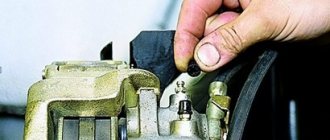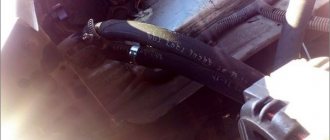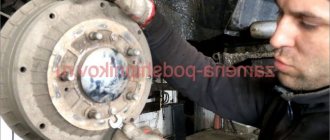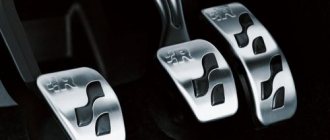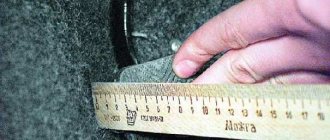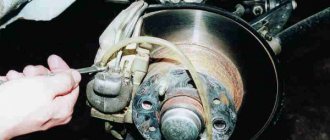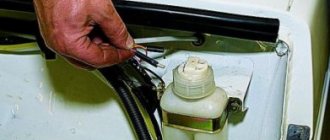see also
Which brake fluid is better
- 6 0 11k
Replacing brake fluid
- 28 0 26k
How much brake fluid do you need to change?
- 66 1 105k
Master brake cylinder repair kit
- 10 0 29k
Brake fluid DOT 4
- 74 1 82k
Knowing how to bleed brakes will be useful to any driver, since the procedure is not very complicated, and it must be performed after many manipulations related to the brake system. So why waste extra money once again by sending your car for service when you can pump the brakes alone?
By following the instructions and avoiding the mistakes described below, it is quite possible to remove the air from the brakes yourself, with or without ABS. Bleeding brakes with ABS is by no means more difficult, but still it is a separate topic worthy of its own article.
It is only worth noting that if there is an anti-lock braking system with ESP and SBC modules, then the path lies with a service that has the necessary equipment.
What you need to know before starting work
Before you begin the renovation, you need to know a few things that will come in handy during the process. It is very important to know how to properly bleed the brakes on a passenger car. Please note that it is necessary to use fluid exclusively from the manufacturer and brand that was previously in the system. If you recently purchased a car and for this reason do not know what fluid was in the tank, you must resort to the car manufacturer's recommendations. There is a high probability that the previous owner also paid attention to these recommendations. You will also need a partner to help you bleed the brakes. Its function will be to press the brake pedal in a timely manner, thereby creating pressure in the brake system.
Procedure for bleeding the brakes
You can pump the brakes yourself, or you can have an assistant, whose task is to press the brake pedal on command. The procedure for bleeding the brakes should be found in the manual for a specific car.
If the diagram is not indicated, then bleeding is done in the form of the letter Z. This means that you need to pump in this order : right rear - left rear - right front - left front wheel.
To bleed the brakes, you will need a brake fluid container and a clear rubber hose.
How to bleed the brakes
First you need to get convenient access to the brake system bleeder fittings. To do this, you can put the car on a lift or platform and remove all the wheels. Don’t forget to clean the fittings near each wheel from dirt and pour a little “brake fluid” into the prepared container.
Instructions:
- Pour new brake fluid into the master cylinder reservoir.
- Connect the hose to the fitting, and lower the other end into a container with brake fluid.
- Command your assistant to press the pedal several times and hold it depressed until the fluid flows.
- Unscrew the fitting and the liquid will flow into the container you prepared. Carefully monitor the fluid level in the tank and add as necessary.
- Repeat the previous 2 steps until the brake fluid comes out clean without air bubbles, and tighten the fitting.
- Repeat the same procedure on the remaining wheels.
Bleeder fitting on the brake caliper. A hose is put on it
Features of bleeding brakes with ABS
Thanks to the use of modern technologies, designers managed to significantly improve the car's braking system. Most recent models are equipped with an ABS brake system. It allows you to synchronize the speed of rotation of the wheels during skidding or emergency braking. This evens out the vehicle's ride on slippery road surfaces and significantly shortens the braking distance.
During braking, the central console receives signals from the sensors of the front and rear wheels. The rotation of the wheels is effectively slowed down at the same speed as the speed of the vehicle. Tests and calculations have shown that such a braking system is most effective in any weather and on any road surface.
Picture of a braking system with ABS
Despite the technical differences between ABS systems for different car brands, all devices have the following components:
- Acceleration and deceleration sensors located on the wheel hubs.
- Control valves that regulate the pressure in the line of the main brake system.
- An electronic unit that processes signals and uses them to regulate the position of the valves.
Advice: When buying a car with ABS installed, you should not relax. The system only helps in emergency situations on the road, and does not completely take control into its own hands.
Manufacturers recommend bleeding brakes every 50-60 thousand kilometers. In addition, you need to periodically inspect the brakes. During operation, air sometimes gets into the sealed system with brake fluid. This is due to small cracks in the pipes or loose connections.
Bleeding allows you to remove excess air and make the braking system as efficient as possible. In practice, the main signs of the need for pumping are:
- the brake pedal moves more smoothly, the working stroke of the car has increased;
- air sometimes enters the system after repair work on other vehicle components;
- The level of brake fluid in the reservoir has dropped sharply.
For cars with an ABS system, bleeding is somewhat more difficult. But if you know the technology and perform all the steps in the correct order, then such work can be done without the involvement of specialists. This applies to both domestic cars and foreign cars.
Each model has its own characteristics of bleeding the brakes, so before starting repairs, find instructions specifically for your car.
Each model has its own characteristics of bleeding ABS brakes
How to pump correctly (procedure of action)
Such repairs require not only theoretical training, but also some practical skills. Therefore, if you know a car enthusiast who has already pumped the brakes, it would not be a bad idea to call him. The pumping itself differs depending on the design features of the car. If the hydraulic accumulator, pump and hydraulic valves are in one place, then the operation will be similar to models without ABS.
What tools are needed for repairs?
In addition to the usual plumbing tools, special equipment may be required, such as a scanner. It is used to read information from the electronic unit. In some models, in addition to the ABS system, additional motion control systems are installed. In this case, it will be better to take the car to a service center, since pumping will affect the operation of other systems.
Regardless of the type of ABS, there are several rules for carrying out repairs; this scheme must be followed in any case. Since the maximum pressure in the hydraulic system is 180 atm, it must be reduced before starting repairs. To do this, turn off the ignition and press the brake pedal about 20 times. Thus, a certain amount of liquid is released and the pressure drops. After turning off the ignition, disconnect all connectors on the brake fluid reservoir.
To relieve fluid pressure, press the brake pedal about 20 times.
Tip: Bleeding the brakes on the front and rear wheels is different; it is important to perform the work in the correct sequence.
Bleeding the front wheel brakes
- We put the hose on the bleeder fitting;
- Open the fitting 1 turn; Open the fitting 1 turn
- At the same time, the second person depresses the brake pedal and holds it in this position for some time;
- We observe the exit of excess air from the system; Watching the air come out
- After clearing the pipe of air, you need to tighten the fitting and only after that you can depress the brake pedal.
Rear right
- We put on the hose and turn the fitting 1 turn;
- Press the brake pedal and turn the ignition switch to the number 2;
- At the same time, the pump is turned on, which removes the liquid with excess air from the system;
- After the “air” liquid comes out, close the fitting;
- Release the brake pedal and turn off the ignition.
Rear left
- After a short period of time, fully release the pedal and wait until the pump automatically turns off.
- After excess air has escaped, tighten the fitting and press the pedal halfway;
- Do not depress the brake pedal, the fluid will begin to come out under the action of the pump;
- We repeat the first point, as for the rear wheel; We securely clamp the connectors and check all connections
- Turn off the ignition and connect the connectors back to the brake fluid reservoir. We check the reliability of the connections and look at the ABS system operation indicator. It should go out if everything was done correctly.
Video tips (upgrading Mitsubishi Pajero 3)
The nuances of working with ABS on different car models
Considering that the ABS system on domestic and foreign cars has its own characteristics, it is worth preparing in advance the necessary tools and equipment that will be needed to bleed the system correctly.
- when the pump and hydraulic accumulator are located in one unit, pumping is significantly simplified, no special equipment is required;
- if located separately (like most foreign cars), you need to use an electronic scanner to read data from the control unit;
- In the case of additional control systems, you should not bleed them yourself, but still contact a service to bleed ABS brakes
To adjust the operation of the braking system with ABS, you need to study the technical documentation for your car and determine the location of the main elements of the system. Carrying out such repairs is not difficult, but you may need the help of a friend to adjust the position of the brake pedal when the fluid comes out.
autozam.ru
When to bleed the brakes
The brakes are bled when it is necessary to remove air from the brake system. This often happens when replacing brake fluid, which is done approximately every 50-60 thousand km. mileage or once every 2 years.
It is also necessary to bleed the brakes after repairing the brake system: replacing the master cylinder or vacuum brake booster. The need for bleeding also arises when depressurization occurs due to damage to the hoses, or when the liquid in the expansion tank drops below the minimum mark.
The pedal will indicate that you need to bleed the brakes - it will become soft and begin to sink. And the brakes themselves will become more sluggish. However, this may also indicate a more serious problem with the brake disc or pads. So, if bleeding does not help, perhaps you should still contact a specialist - brakes are no joke!
Bleeding brakes with abs - bleeding diagram
Thanks to technological progress, almost all modern cars have a braking system with ABS function. The automatic locking system protects the vehicle's wheels from locking during emergency braking by controlling their rotation speed. Thus, the wheel sensors transmit impulses to the ABS electronics unit, the reaction of which regulates the entire braking process. Monitoring the health of the car, including the brake system, is very important. Bleeding ABS brakes is necessary to remove excess air from the hydraulic drive, which could get there during repairs or replacement of brake fluid. The presence of air in the mechanisms is unnecessary, because it negatively affects the operation of the brakes. You can determine the need for bleeding yourself by pressing the brake pedal several times. If, when you press the pedal, you feel it is too smooth and moves harshly, then it is necessary to restore the tightness and bleed the brake system of your car. This can be done both with the help of specialists and on your own.
Use only new brake fluid, and only one that meets the technical specifications of your car.
The brake bleeding diagram, or, in other words, the brake bleeding sequence, should look like this:
- front left wheel mechanism;
- front right wheel mechanism;
- rear left wheel mechanism;
- rear right wheel mechanism.
This is the sequence in which the brake bleeding process should take place. Starting the pumping procedure itself, provide comfortable access to the relevant mechanisms with which you will work - remove the desired wheel, or drive the car into the inspection hole.
Procedure for bleeding the brakes.
- Remove the cap from the expansion tank.
- Unscrew the brake bleeder fitting and clean it of any buildup.
- Place a clean hose onto the fitting of the corresponding brake mechanism, lowering the free end into a reservoir filled with brake fluid. Due to the fullness of the container, air does not enter the cylinder through the fitting.
- Start the engine and leave it running.
- Press the brake pedal several times (your assistant can do this) until the brake fluid flows through the hose into the reservoir. Perform these actions as long as the brake pedal allows, until it hits the floor.
- Bleed the brakes until all the air is out of the mechanism, while constantly refilling the reservoir with new brake fluid. The tank should not be completely empty, otherwise it will fill with air again. This system is used for cars with a manual transmission.
- Tighten the abs bleeder fitting. Tighten it while the pedal is reversed to prevent air from entering.
- Remove air and fluid from the clutch hydraulic drive as well.
- Add fluid to the expansion tank to the maximum mark.
- Check the action of the brake pedal; it should be depressed 1/3 of the entire pedal stroke.
In the same way, bleed the mechanisms of all four wheels of the car. But when bleeding the rear brakes, the fluid must be pushed out first with the engine on and then with the engine off. After completing all the procedures, carefully inspect the brake system components of your car, make sure that all elements are securely fastened, and whether there is enough fluid in the tank. There are cases in which the brake pedal fails; this can only mean that the work was not performed correctly.
When bleeding air from the brake system, do not allow the electric pump to operate for more than 2 minutes.
Start the engine and press the brake pedal several times, the resistance should be uniform. Hold the pedal for several seconds to make sure the mechanisms are working properly. Drive the car, test the braking system at all speeds, check the operation of the automatic locking system by performing emergency braking.
Some ABS systems are designed in such a way that this process requires a special brake bleeding device. As a result, any operations that require intervention in the vehicle’s braking system must be carried out by specialists from a service station, just like wheel alignment.
Video - “Bleeding the brakes yourself”
autoremka.ru
How to bleed brakes without an assistant
How to pump the brakes with a partner has already been described above. What to do if there is no such thing nearby, but you need to bleed the brakes? You can get out of this situation in several ways:
- You can bleed the brakes alone if you have a gas stop . The meaning is the same as when pumping with an assistant, only instead of him the gas stop will press on the pedal. Therefore, you need to press the pedal several times, keep it pressed, set the stop and begin to bleed the brake fluid. When the fluid begins to flow, the stop will begin to push the pedal to the floor to the limit.
- bleeding the brakes with a syringe . You need to hermetically embed the syringe into exactly the same lid as on the tank. Then, having first filled the syringe with brake fluid, replace the regular cap with this device, unscrew the fitting, place a container and apply pressure with the syringe.
- another method with a modified lid . You need to insert a car nipple into a cap similar to the one installed on the tank. Then put the lid with the nipple on the tank, then put one end of the hose with a connection clamp on the lid, and the other on the spare chamber, inflated to no more than 1 atmosphere. Open the fitting and bleed out the liquid with air bubbles.
Replacing brake fluid and bleeding brakes
Problems with the brakes of the VAZ-11113 Oka
18 July 2020, 17:21 #1
Is it possible to remove the brake regulator? When braking at a speed of 50 - 60 km/h, the wheels are beating, the brake discs are machined, the wheels are balanced
18 July 2020, 18:09 #2
And the point of cleaning the brakes. regulator What does “wheels beat” mean? Vibration when braking. Then here it is: “Brake deformation. disk. Increased axial play of the wheel (wear of the front wheel bearings or loosening of the hub nut). Ovality of the brake. drum. Brake lining The pads have peeled off from the base. The tension spring of the rear brake pads has weakened or broken.” “Sorcerer” (braking control) has nothing to do with these cases.
February 8, 2020, 10:49 #3
The front seal of the GTZ drips and the brake fluid gets into the VUT, once every 2-3 weeks you have to add a thimble of fluid. Is it possible to eliminate this with “little blood”
VUT works, brakes are fine..
February 8, 2020, 12:22 #4
Glebz, February 8, 2020, 10:49, #3
The front seal of the GTZ drips and the brake fluid gets into the VUT, once every 2-3 weeks you have to add a thimble of fluid. Is it possible to eliminate this with “little blood”
VUT works, brakes are fine..
“Little blood”, usually this is a repair kit from the classics.
8 February 2020, 13:42 #5
Those. replacing the GTZ oil seal, as I understand it? Will it be necessary to bleed the system (hemorrhagic)?
March 15, 2020, 10:14 #6
Is it possible to replace the GTZ without subsequent bleeding of the brakes? They claim that you can fill the GTZ with brake fluid before installation (filling the reservoir with liquid), close the channels with complete plugs and tubes after disconnecting, and after installing the GTZ, remove the plugs and connect the tubes. Will it be possible to prevent air from entering the system in this case? Who has experience and what do they think?
March 15, 2020, 10:25 #7
Glebz, March 15, 2020, 10:14, #6
Is it possible to replace the GTZ without subsequent bleeding of the brakes? They claim that you can fill the GTZ with brake fluid before installation (filling the reservoir with liquid), close the channels with complete plugs and tubes after disconnecting, and after installing the GTZ, remove the plugs and connect the tubes. Will it be possible to prevent air from entering the system in this case? Who has experience and what do they think?
It is important that there is no liquid in the tank, but that it does not leak out of the unscrewed tubes. After installing the cylinder, do not tighten the tubes completely and allow the liquid to “flow” through the connections. But there will still be air in the system.
March 15, 2020, 10:44 #8
It’s a pity, I would like to do without pumping (important!).
Thanks for the advice!
17 March 2020, 17:53 #9
But what prevents you from adding brake fluid from a syringe into the ends of the tubes if it has leaked out a little? Servicemen often don’t perform pumping. I personally am for pumping. but decl air won't hurt. IMHO.
17 March 2020, 18:10 #10
slawko, 17 March 2020, 17:53, #9
But what prevents you from adding brake fluid from a syringe into the ends of the tubes if it has leaked out a little? Servicemen often don’t perform pumping. I personally am for pumping. but decl air won't hurt. IMHO.
Why a syringe? Let it leak from the GTZ, and let the air come out of the loose fittings.
Mineralnye Vody, formerly Pechory
Toyota Yaris Oka 1113
March 17, 2020, 10:17 pm #11
It’s been a while since I’ve been pumping the brakes myself (by the way, in the Urals too).
You just need to imagine the brake fluid in the tubes, like a flexible wire.
A transparent tube, a container half full of old TJ, a suitable stick. He opened the caliper fitting, pressed the pedal with a stick, rested it on the seat and ran to close the fitting. And so on several times per wheel until the bubbles in the tube run out. All! And you don’t have to press the brake pedal a dozen times.
Well, where to go when you’re alone?
6 August 2020, 14:09 #12
When you press the brake pedal with the engine not running, the pedal reaches the start of braking (the pads rest against the braking surfaces), then with further pressing, as if with a soft click (like a step), it falls another 5-10 mm. and then the pedal is hard as it should be (and this happens every time you press it).
I’m wrong that either some cylinder (caliper) is jammed or some kind of block (most likely the rear one) is catching on something, or maybe the “sorcerer” is to blame. For one thing I can’t figure out the reason. I don’t want to shake up the entire brake system (but apparently You'll have to.) Maybe someone has had this happen or has thoughts about it.
